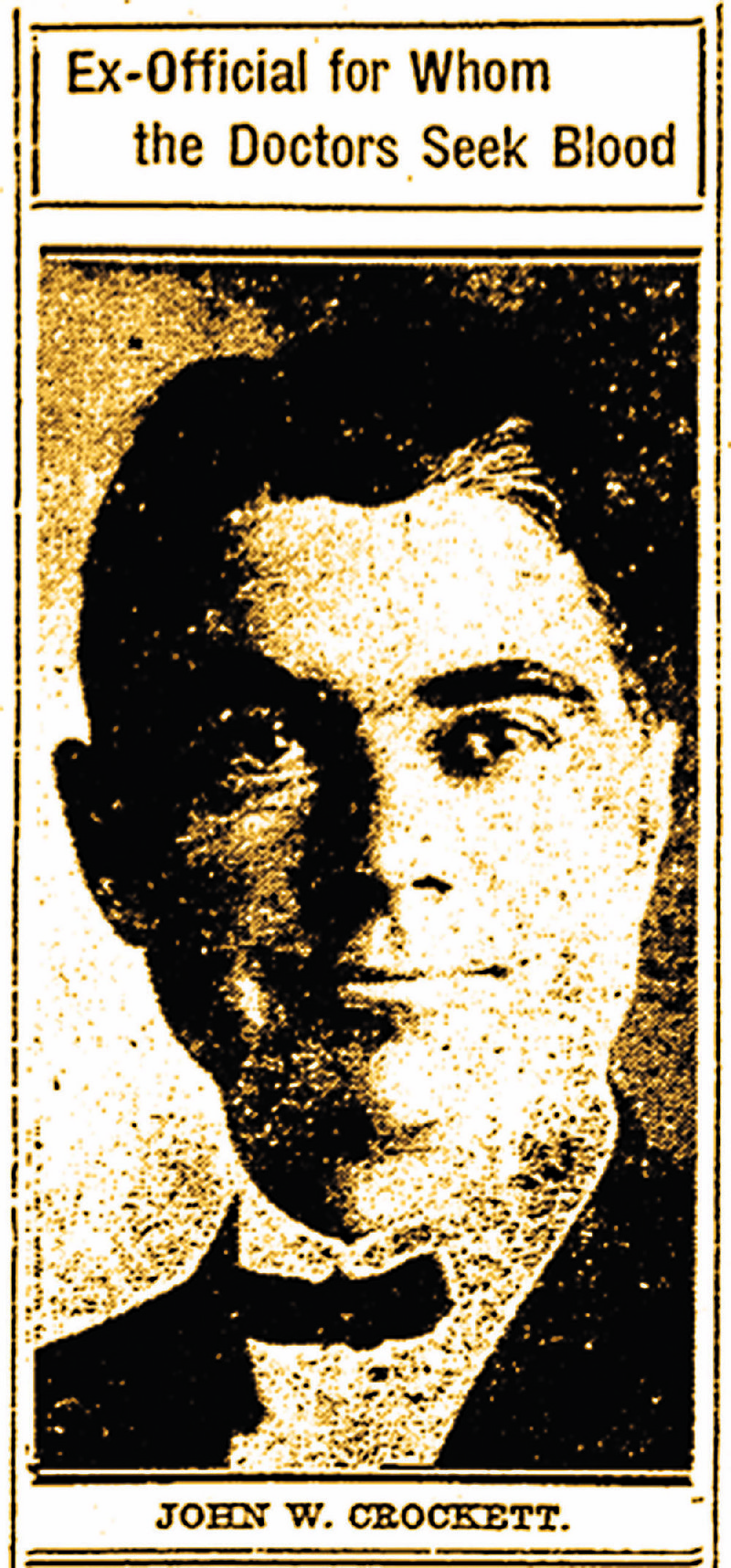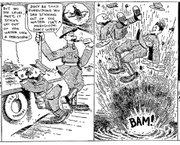When nobody knows how famous you are, it's great to have a great ancestor.
A descendant with some moxie of his own can climb proudly onto the giant's shoulders and rise above the crowd. Who is a personnel director more likely to call back, Davy Crockett's great grandson or the great grandson of Joe Nobody?
Of course, it's a long drop off lofty shoulders, and the unrelated and envious public does delight in watching one fall.
But let's focus on the affirmative, a case in which having a noted forbear seems to have helped a descendant by inspiring heroic efforts to save his life. Consider the case of John Wesley Crockett (1860-1920).
On June 6, 1918, Page 1 of the Arkansas Gazette updated readers with the latest word on an ongoing nightmare: German U-boats were planting mines in American waters off the Eastern Seaboard and sinking merchant ships -- to that date, five steamers and eight schooners.
Also, 200 Creek Indians at Henryetta, Okla., were being blamed in the deaths of three farmers and were refusing to present themselves for military service. And in Europe, the latest German offensive appeared to have stalled at the River Marne.
Competing with these items for attention was an appeal for blood to save Davy Crockett's great grandson, John W. I would say "blood donations," but the offer was $50 for a pint and a half.
A transfusion of a pint and a half of blood is considered necessary by the physicians attending John W. Crockett, former state treasurer, who has been confined to his home, 2408 Gaines street, for the last four months because of an illness due to lack of red corpuscles.
From his eventual obituary in the Little Rock Daily News, we know the eldest son of Davy Crockett's grandson Robert H. Crockett was a Methodist (duh) and was born at Mount Adams on the White River, near Crockett's Bluff.
Arkansas County was a hotbed of farmer Crocketts -- but not of public education. Neighborhood schools met two or three months a year.
But like his famed ancestor, John W. was a country boy with a bullet.
At 16, he quit farm life to work in a drugstore in DeWitt, where at odd moments and at night he read law books. He received his license to practice at age 22.
He married in 1884. Two years later, with wife Sallie he moved to Duluth, Minn., to be a special agent in the land office under President Grover Cleveland's administration; he worked in New Mexico and Minnesota.
In 1889 he quit that job and went back to the drugstore in DeWitt -- where he ran a few times for county office, becoming county clerk and then getting himself elected to the state Legislature. He and Sallie moved to Little Rock in 1899, where she died in 1904.
He remarried in 1907 and had one daughter, Elizabeth. I could go on with this, but suffice to say John W. was secretary of state from 1901 to 1905, state railroad commissioner from '06 to '11 and state treasurer from 1911 to 1915.
From the Gazette, we know that by 1918 he had pernicious anemia, a condition described thus (in an unrelated story in 1919):
Pernicious anemia, that obscure disease from which so few persons recover, is a condition in which there is an increased destruction of blood corpuscles rather than a lack of production of blood. Very little is known about it ...
In almost every case of pernicious anemia, some focus of infection is found. In some this is the gall-bladder, in others the appendix, while in some it is the teeth or the tonsils. The first step in treating the disease is to get rid of the focus of infection. The blood is transfused into the patient's veins, and his spleen is removed.
We don't know whether Crockett kept his spleen, gall bladder, teeth or tonsils. But we do know Little Rock newspapers put out the word he needed help; Arkansans stepped up to give him their blood; and he recovered -- for a while.
Back to the first appeal, which included women as well as men, and which suggests the relative novelty of blood donation:
Women often have purer blood than men. Not only must the blood be healthy, but it must mix with Mr. Crockett's blood. After testing the blood offered as to its purity samples must be placed with Mr. Crockett's blood to see if they mix properly.
Blood groups had been discovered in 1901, and an American surgeon, Dr. Reuben Ottenberg, introduced the idea of cross-matching donors and recipients in 1907.
In the past, the Gazette said, transfusions often killed the recipient because the test for mixability was not done. It still wasn't a step to be taken lightly, but his medical team, Drs. Morgan Smith and A.C. Shipp of Little Rock and one "Dr. Green" of Hot Springs said he would die without it.
On the afternoon of June 6, the Arkansas Democrat followed the Gazette's announcement by reporting that "many friends" had stepped forward and the transfusion would likely be made the next afternoon, during a surgery (goodbye, teeth? spleen?). But that report was too optimistic.
On June 7, the Gazette reported that everyone who was volunteering wanted nothing to do with money. One donor was promising:
It is probable that the blood of this woman, who seems particularly strong and healthy, will be tested first to see if it is suitable.
She wasn't a match, because by June 9, the Gazette reported the doctors and Crockett himself had fielded about 100 offers, in person and in letters from DeWitt. Tests would begin to be made on the 10th.
On June 12, his conditioned remained unchanged -- and no blood was suitable.
July 25 brought the good news that a transfusion had recently been made, and he was improving rapidly. He was beginning to be able to walk.
But in March 1919, the Gazette checked in to find him still confined to home and suffering from pernicious anemia. He was "said to be" doing better, having received a quart of blood some months before.
Crockett survived until April 8, 1920. Gov. Charles Brough closed the state Capitol in memorial.
Crockett was taken home to DeWitt, where he was buried below a Woodmen of the World headstone.
Because I married an indirect descendant of Davy, my impression has been that since he and his brothers ventured through eastern Arkansas in the 19th century, the Crocketts have been seeding descendants across the 75 counties. So I searched the secretary of state's 2017 voting rolls for the last name Crockett, expecting to pull up, oh, 1,000 or so.
But, no, the rolls list only 273 voting Crocketts.
What about people with Crockett as a middle name? Hmmm, just 14. And before you ask, only seven voters carry Crockett as their first name.
Compare that to Hutchinson, with 256 last names, or the last name Smith, with 24,918.
Today, living as we do among -- let's say -- more than a few Davy descendants, being related to the hero of the Alamo might not bring blood donors rushing to your bedside, but still, there are worse burdens.
Email:
cstorey@arkansasonline.com
ActiveStyle on 06/04/2018

